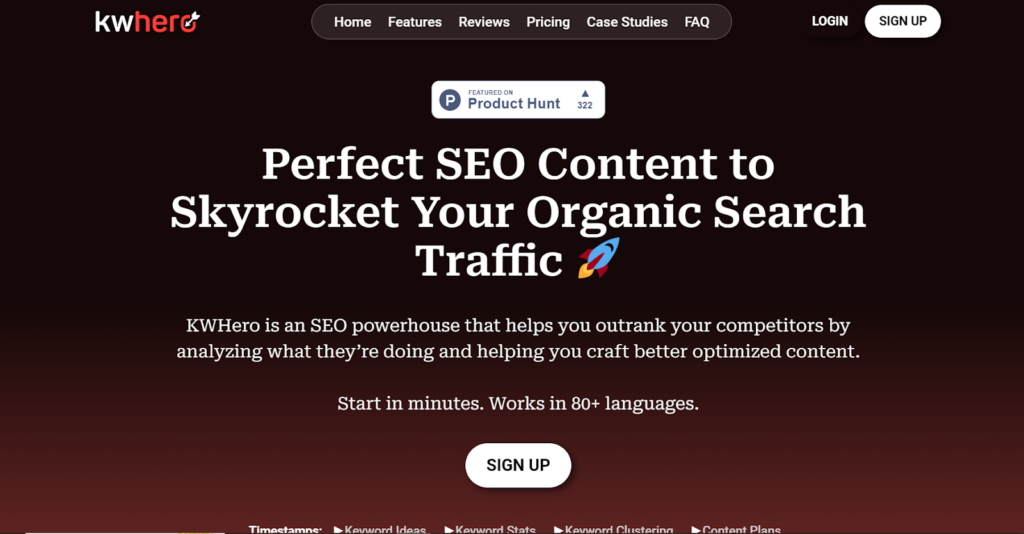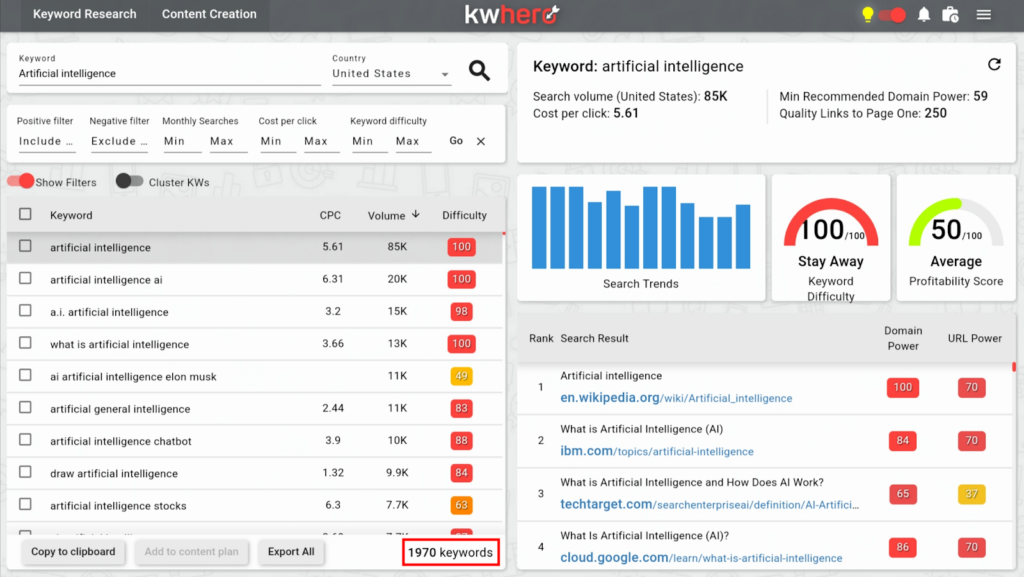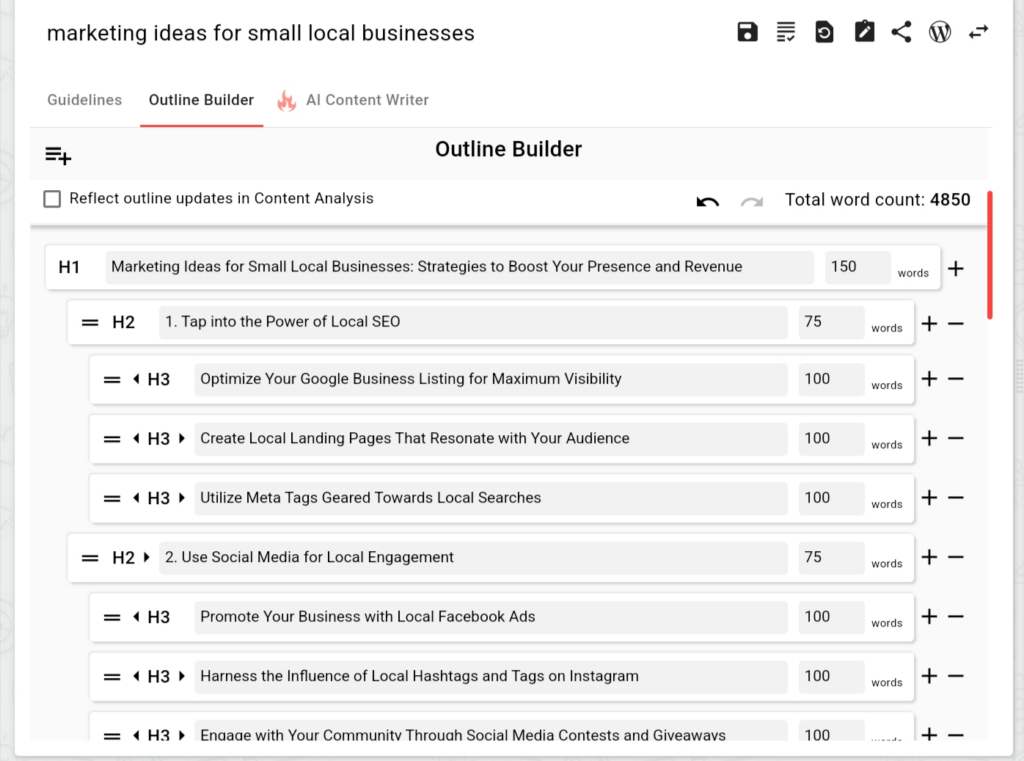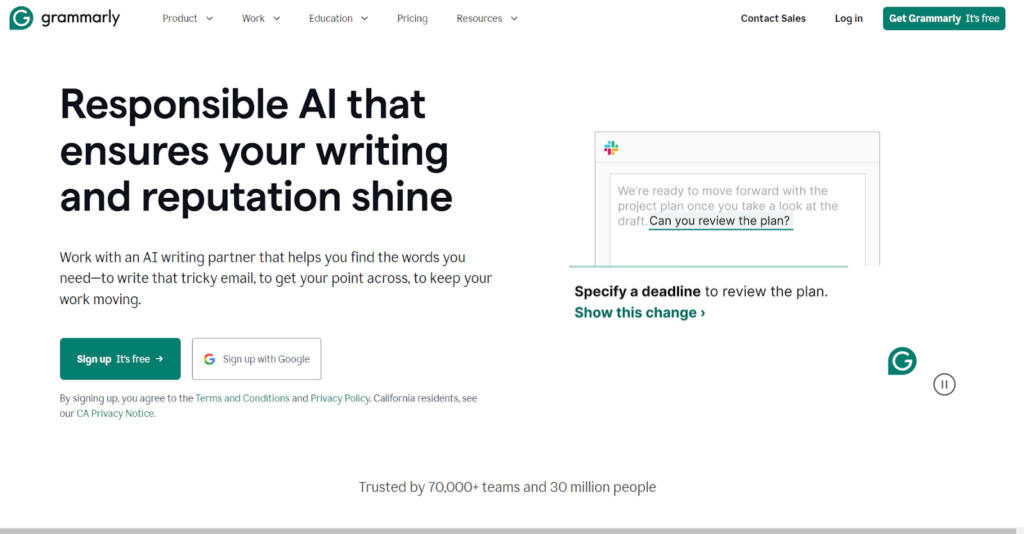Since OpenAI’s launch of ChatGPT just a few years ago, artificial intelligence has rapidly found its way into the operating procedure of many companies – large and small – across the world today.
Some people fight it and try to do things in the ways that they are used to.
This is totally fine, as there’s more than one way to get a job done. But, it doesn’t change the fact that AI offers the opportunity to scale multiple parts of a business significantly and in record time too.
One part of business in particular that can be scaled with AI is the marketing process or, more specifically, the content creation process.
But, with so many AI tools offering to do so many things, it can be a little overwhelming deciding where to fit everything.
Worse still, you might even be left with a situation where you’re spending more time trying to create the most efficient process with the multiple AI tools available instead of simply creating content.
As such, in this article, we’ll be showing you how to scale your content creation process with artificial intelligence and provide practical knowledge and tips along the way.
Content Scaling in Context
To be sure that we’re on the same page, content scaling, as we’ll be referring to it in this article, means increasing the amount of high-quality content you can produce and publish within a given period.
If, for instance, you were only putting out one high-quality piece, perfectly written, researched and edited every 14 days, content scaling would mean doing that same type of content twice each week. That’ll be a total of four articles every two weeks as opposed to the one you were producing before.
The importance of doing this cannot be overstated. At the very least, sometimes, it’s a numbers game. Here’s the logic behind that statement:
- With an engaged audience, perhaps the worst thing you can do is randomly leave them to wonder why you’ve gone silent for so long, leading them slowly away from your business/site.
- With more high-quality content online, you have a greater likelihood of ranking for more things on Google and ultimately bringing in more leads or site visitors.
Summarily, you can increase your reach and keep your audience engaged.
Common Barriers to Content Scaling — Signs You Might Need to Turn to AI
Not everyone needs artificial intelligence to scale their content creation process.
Even before OpenAI came into the scene, companies like HubSpot were already beasts in their own right, producing articles frequently enough to retain the attention they’d worked so hard to gain over the years.
But, that might not necessarily be you. At the very least, you probably don’t have the billion dollars in revenue that HubSpot has and can throw at their marketing problems.
So, in case you’ve found yourself wondering whether or not you should actually turn to AI, here are two main barriers that might be a sign that you need to turn to it to scale your content.
1. Limited Resources – Time and Money
There are only so many hours in a day and there is only so much money that a company or website can afford to put into marketing before they begin running into operational troubles.
Yes, everyone gets the same 24 hours in a day.
But if your team is meant to use those hours for other purposes, it’s likely causing them to de-prioritize the content creation process and instead try to complete their other tasks.
Unlike the number of hours in a day, the distribution of money among companies is very different.
With limited funds, you’re less capable of running marketing campaigns to distribute your content or hiring a bigger team for your content scaling efforts and projects.
This barrier might be a sign that you need AI to help make your content creation process bigger and more efficient.
2. Consistency in Tone and Voice
Many companies tend to outsource their content creation. It’s the whole reason agencies and freelancers exist.
For the most part, they tend to get the job done, assuming you can look past some of the incredibly high prices they charge.
Unfortunately, the problem with outsourcing to these entities, especially if you’re trying to create content at scale, is that they do not necessarily know your company as well as you do.
So, you’ll likely have a lot of content but it’ll feel disconnected from your brand. While it’s bad enough that you’ll notice, what’s worse is that your audience will feel that disconnect, too.
With AI, getting the right tone is as simple as including a prompt for it to sound a certain way and then editing afterwards.
Strategies and Tools for Scaling Your Content Creation with AI
There are different stages of the content creation process. To keep things streamlined, we’ll separate our techniques for content scaling with AI into these stages.
We’ll also be focusing largely on written content as things get significantly broader when you move into other forms of content creation. That said, let’s jump right into it.
1. Research and Outlining
This is often the first stage of any content creation process. If you know the subject like the back of your hand, the chances are that you can probably skip this stage. After all, most of the things you want to write about are second nature to you.
But, the longer you stay in content, the more unlikely it is that you’ll have existing knowledge about everything that you want to write on.
So, you’ll probably have to research the content beforehand and then generate an outline based on your findings.
Typically, this process can take anywhere between a few minutes to several hours. For a one-off article, depending on the length, it might not seem like much.
But, if content scaling is your goal, the hours add up fast and you simply need a more efficient way to do it.
Artificial intelligence can cut down significantly on the time needed for tasks like that.
Useful Tools for Scaling Your Research and Outlining Process in Content Creation
One of the best ones on the market that we can recommend is KWHero.

It’s an AI-powered tool that’s built to help you rank on search engines by looking at what your competitors are doing and outdoing that through great content.
Its research features are split into a few different paths. One of them is keyword research.
The tool has an expanding database of keywords that you can look up to see if a particular piece of content would be right for you to invest time and effort in.
With this section of the tool, you have access to details such as cost per click, keyword difficulty, average profitability score, etc.
As such, you can skip all the guesswork of trying to decide whether X topic would be great for you or Y keyword would give you an edge over the competition.

Outside of keyword research which, between us, can be a drag sometimes, there’s also the competitor analysis. With this function, you can see which of your competitors are ranking for a keyword you’re looking to create content on.
The tool gives you a top ten list. On that screen, you can go ahead and read the content manually to see what they’ve already said and how you can improve it.
Alternatively, if you really are looking to scale your content creation, you can simply toggle on or off the competitors you think are most relevant to the type of content you’re trying to create. The screenshot below perfectly captures your freedom in that regard.

Once done, KWHero will comb through the sites you’ve chosen, pick out their headings and content and create a unique outline for you in minutes.

Just like that, you’ll have completed much of the research stage of your content creation process and it only cost you a few clicks to get to that point.
2. Writing and Editing
Some people believe that writing is actually the easiest part of the content creation process. To an extent, we agree.
You see, during the research phase, you’re consuming as much content as possible, spending hours trying to gather all the information you can get on a subject.
Then, mentally or otherwise, you’re filing and organizing all that knowledge so that you can create a coherent outline with which you can write your content.
As we explained earlier, this can take anywhere from a few minutes to a few hours. If you’re trying to scale your content creation, then you’ll likely be on the longer end of that spectrum.
Writing, however, is what happens when you’re done with research. You already have all the ideas in your head, you simply need to pen them down.
This might be difficult for some people but for a content specialist, it shouldn’t be much of a problem. So, it typically takes a fraction of the time spent on research.
But, it still can take a considerable amount of time to complete. Plus, even if the writing process can be swift, the editing process would need to be meticulous, slow, and nitpicky.
It is, after all, the stage where you find everything that’s wrong with the content and correct it in the endless white ocean that is your Google Docs file.
With artificial intelligence, it is possible to cut down the entire writing time to mere minutes. This is perhaps one of the most incredible things about generative AI in recent years.
Useful Tools for Scaling Your Writing and Editing Process in Content Creation
Content Writing
For AI-powered content writing, there’s a broad range of options but our choice is KWHero. Stay with us here.
GPT comes in different versions, some of which are more advanced than the other. GPT3.5, for example, is incredibly fast and can produce tons of content.
But, it is going to have trouble following instructions or generating content as well as GPT4 or GPT4 Turbo. On the bright side, though, it is noticeably cheaper.
Some writing tools know this and, as such, despite the reduction in quality, they build their content writing infrastructure on GPT3.5. After all, it is cheaper.
KWHero, on the other hand, finds the balance between pricing and quality by using GPT4 Turbo.
So, you’re going to be getting AI-generated content but you’ll be getting excellent quality such that you can rest assured your content stands a chance to rank and even engage your audience.
Besides the quality of content, by using KWHero to scale your content creation process, you’ll be getting the advantage of neatly organized content plans. There, you can store multiple keywords and work simultaneously on projects as required, allowing you to knock out multiple content production KPIs at lightning speed.
Editing
AI-powered editing brings one name to mind – Grammarly.

That’s not particularly surprising. The tool has been on the market for a couple of years and it has continuously improved its product.
While you might not need to edit KWHero articles for grammatical accuracy, you can still consider adding Grammarly to your arsenal under one or more conditions:
- First, you’re writing your content manually or making significant changes to KWHero and you want to manage your errors.
- Second, you’re trying to have your articles adhere to a certain tone as defined in Grammarly.
Either way, the tool will do you a lot more good in terms of saving your time than trying to handle all your content editing needs solo.
3. Distribution
The content creation process is not complete until you get it to the audience that’s meant to consume it. Otherwise, you might’ve as well just thrown a spaceship into the void, hoping it will find extraterrestrial lifeforms.
It probably won’t and, in the same vein, your content probably would not find the audience magically. You have to seek them out and then tailor the content in ways that will actually resonate with them and, if that’s your goal, draw them to your website.
The process of finding out where your audience hangs out is something that you’ll likely have to do manually through proper audience research.
Once you find out, though, you can then go ahead and tailor your content to them by repurposing it to match their consumption habits on the parts of the internet they spend their time.
What that means in practical terms is taking actionable tips from your blog posts and making a TikTok or Instagram reel if that’s where your audience is.
On the other hand, you can make a set of slides for LinkedIn or a thread for X. Whatever it is, AI can help you make all these content transformations pretty seamless.
Useful Tools for Scaling Your Distribution Process in Content Creation
The lowest hanging fruit is ChatGPT. You can simply feed it an existing article and then prompt the tool to create a set of short tweets for you.
If that’s not up your alley, though, you can use other tools like Copy.ai or Automata.
One of your key considerations here should be the quality of output. If it’s not something you’d like to see in your daily scrolls, your audience might not be too psyched about it either.
What Sort of Content Should You be Looking to Scale With AI?
Depending on the sort of website or company that you own, not every type of content is going to be perfect for scaling.
Some things simply need a bit more time to be great or a different type of input than an AI writer can reasonably provide.
The content types you’ll be most successful with for content scaling are blog posts, how-to guides, informative/educative articles, listicles, etc.
Others that might not be so great to try to scale with AI include research or interview-based articles, YMYL content, etc.
For context, YMYL means Your Money or Your Life. It’s a phrase in SEO that describes content that could impact a person’s money or their life.
Since AI tends to be a quick but efficient way to do things and these sorts of content require time, patience and significant amounts of investment, it’s best to simply keep them at the desk of an experienced content specialist.
Final Thoughts
Even outside of the strategies and tools we’ve provided, artificial intelligence has so much more to offer.
You simply have to explore your options and pick what would work best for you based on your audience, business needs and your goals.
In all these, our advice is that you keep your strategy in mind and do not begin unless you have one already. Without a strategy, and we often say this, you might as well be throwing spaghetti at the wall and hoping it’ll stick.
Also, pay attention to content quality, not just quantity and be sure to adapt and change whenever the need arises. This could be in terms of the tools you’re using or the method you’re adopting.
That way, you’re not left behind on the fast-moving AI train.
Godspeed!
